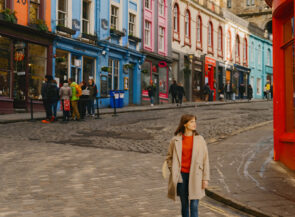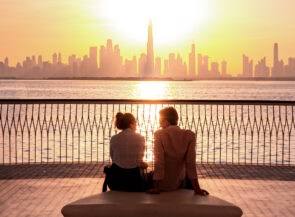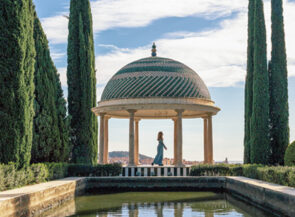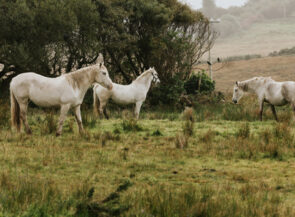Rome is known as the Eternal City, and for good reason. Whether judged using myth (the legend of Romulus and Remus has it that the former founded Rome around 3,000 years ago, after killing his twin brother) or science (archaeologists have unearthed evidence of human occupation going back more than 10,000 years), few cities on the planet have deeper roots. What makes it truly special is that over the millennia the Romans have continually layered present civilizations on top of previous ones—from the Republic to the Renaissance and all the way to the 21st century—giving birth to another nickname: the Big Lasagna. No matter what you call it, whether you go to taste the carbonara or take in the Sistine Chapel, to walk in the footsteps of Julius Caesar or look through the lens of Federico Fellini, the city will live eternal in your memory.
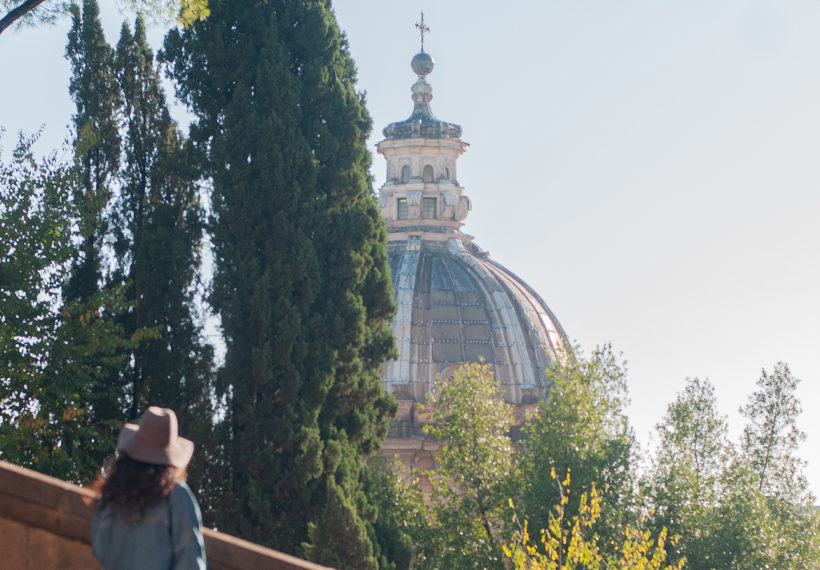
Day 1
Looking up the Spanish Steps, down from Palatine Hill, and around Via Margutta
Riding the escalator up from the depths of the Spagna metro station, fresh off an overnight flight, my girlfriend and I find ourselves standing behind a couple taking wedding photos. This is my first international trip with Kati, so I’m a bit nervous, and I choose to take the happy couple as a good omen.
Exiting the station, we’re greeted by one of the Eternal City’s signature sights: the Spanish Steps, a 300-year-old terraced stairway that climbs from the Piazza di Spagna to the Trinità dei Monti church. Even at 9 a.m., the 135 steps are swarming with tourists snapping selfies—a bunch of which we proceed to ruin as we march through their backgrounds, lugging our bags up to the Hotel de la Ville at the top of the stairs.
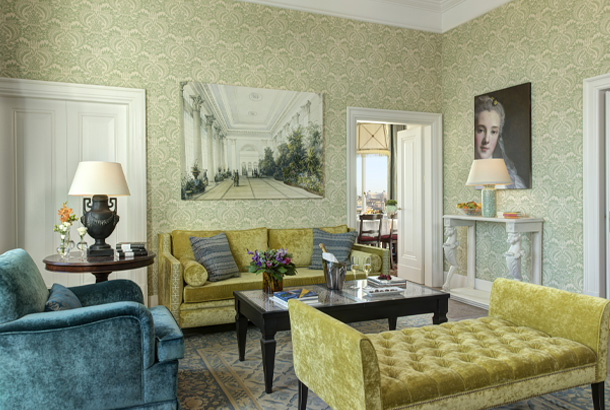
Bags dropped, we descend the stairs and cross the piazza for the can’t- live-without-it first ingredient of the day: espresso. Antico Caffè Greco has been serving coffee on Via dei Condotti since 1760, and the vibe inside is about as Old Europe as it gets. We sip cappuccinos and eat cannoli served by a waiter in a long-tailed black jacket and admire the Renaissance-style oil paintings on the walls. I can see why everyone from Mark Twain to Friedrich Nietzsche has stopped in here—it feels like we’re having our morning joe in the Louvre.
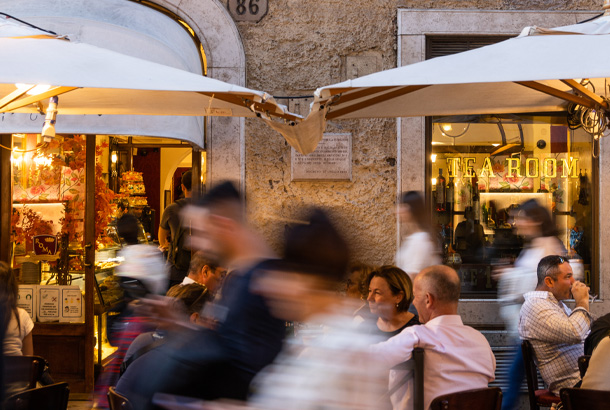
Sufficiently caffeinated—I hope—we’re off to an even older landmark: the Colosseum. A taxi drops us off at the Arco di Costantino, a 1,700-year-old arch next to the arena, where we meet Enrica Armenante, a guide from Through Eternity Tours who’s going to show us around what was once the heart of the Roman Empire. It’s an area she knows well. “When I was a kid, I used to play hide-and-seek in the archaeological area,” she tells us as we climb the cobblestoned Via Sacra, passing through the Arco di Tito to reach the top of Palatine Hill. According to Roman legend, this was where Romulus and Remus were succored by a she-wolf, and it’s where the Roman emperors built their palaces. Armenante points out that the brick structures are merely the bones of the old estates, because most of the colorful marble that covered the bricks was plundered. “If you want to see what Rome was really like,” she says, “go to Las Vegas.”
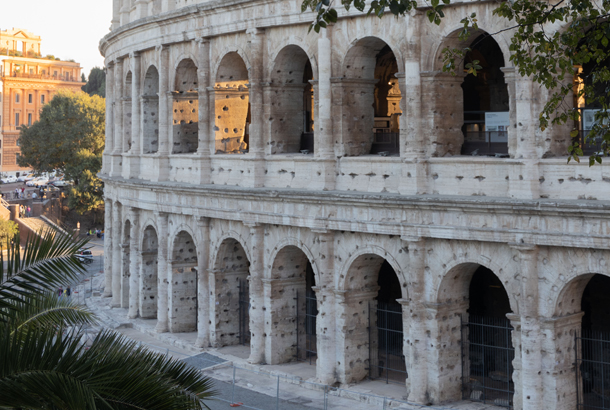
From the top of the hill, we’re also able to look down on the excavated ruins of the Forum and, on the other side, the Circo Massimo, a stadium that could hold more than 150,000 spectators. The poet Ovid was exiled for profanity, Armenante tells us, and one of the books that got him banned included a guide to picking up a girl at the games. “This was the beginning of Western Civilization,” she jokes.
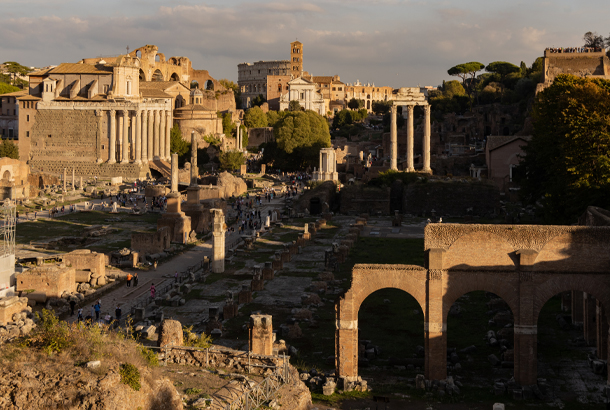
After all that history, the Colosseum feels almost like an afterthought, but when we reach the arena, Armenante shares plenty of tidbits about the games too. My favorite is that the noon hour was for capital executions, which were often staged as reenactments of myths—say, a criminal wearing fake wings being loaded into a catapult on the top level and then launched to the arena floor, falling from the sky like Icarus. The Ancient Romans might have been cruel, but they did have a sense of humor.
After all the walking on that tour we’re ready for lunch, and in the adjacent neighborhood of Monti we find the vine-swathed exterior of Ai Tre Scalini, a bar and restaurant in a 1,200-year-old former winery. In a dining room decorated with Elvis impersonator records and Carnival masks, I order the lasagna, while Kati gets the pollo a la romana con peperoni (chicken stewed in tomato sauce with peppers), which is so good I end up confiscating her plate in the name of “research.” A glass of amarone goes great with both dishes.
We’re sorely in need of more caffeine, and Fulvio De Bonis knows just the place. An art historian and cofounder of Imago Artis, De Bonis has offered to show us an under- the-radar historic spot—but first he zips us to his favorite café, Panella, where he orders espressos with spoonfuls of zabaglione, an Italian egg custard. “This is what I do,” he says: “I bring people to this amazing coffee shop and make them drink coffee the way I do.” He also unlocks places the typical tourist wouldn’t go to. Back at the edge of the Forum, he shows us into the Basilica dei Santi Cosma e Damiano, a church that was built on top of a pagan temple in the 6th century CE. As De Bonis points out, the institution’s age is reflected in the apse mosaic, which portrays Christ with dark eyes and hair—a more historically accurate visage than the blond, blue-eyed one often found in later depictions.
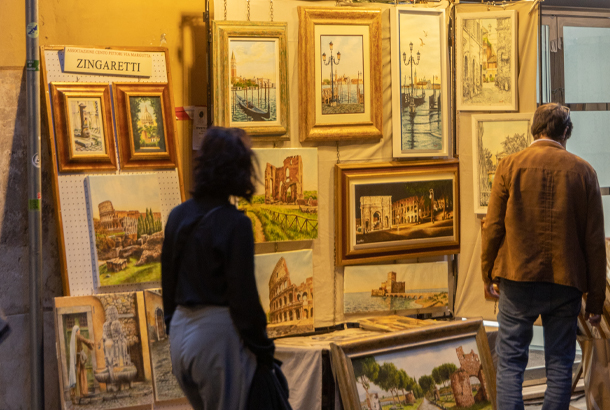
After thanking De Bonis, we head off to pay our respects to a pair of modern deities. In 1953’s Roman Holiday, Gregory Peck’s Joe Bradley brings Audrey Hepburn’s Princess Ann back to his apartment at 51 Via Margutta. The building is unremarkable, but cobblestoned Margutta is one of Rome’s most charming laneways, swaddled in green vines and lined with antiques stores and galleries. We poke our heads into PuntoPelle, a leather jacket shop decorated with mementos from its celebrity customers, including a guitar signed by Carlos Santana. “He sat right in that chair,” the shop owner tells me. “Are you a guitar player?” I am, but I have neither Santana’s skills nor his corresponding deep pockets, so the handsome garments here are out of my reach.
Via Margutta ends just shy of Piazza del Popolo, which we reach just in time for aperitivo at Canova, a café decorated with Federico Fellini memorabilia. As we sip an Aperol spritz (me) and a caffè freddo (Kati) on the patio, a yellow Ferrari rips past us—a perfect Italian exclamation mark.
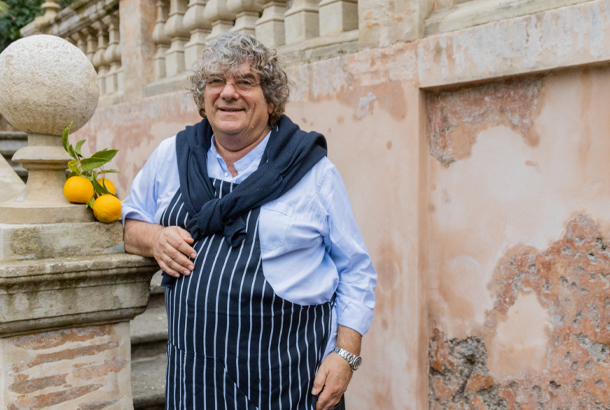
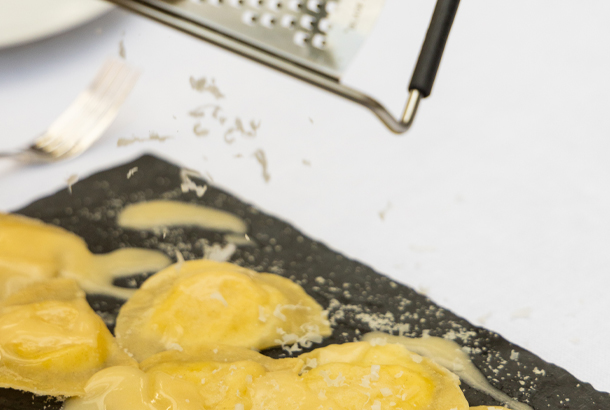
Dinner is just down the block, at Le Jardin de Russie, the signature restaurant at the Hotel de Russie and the brainchild of Michelin-starred Rocco Forte Hotels creative food director Fulvio Pierangelini. We walk through the chic courtyard bar and climb a grand staircase to the dining area, which boasts a hillside garden with a lit-up fountain as its background. We start with Champagne and an amberjack crudo served on a block of pink Himalayan salt; it looks stunning, and it tastes even better. For a pasta, we share cacio e pepe ravioli with eight different kinds of cheese, and for main courses Kati delights in pan-fried sole (deboned tableside) while I dig into a veal fillet with prosciutto (the restaurant’s take on saltimbocca) that’s so good it momentarily breaks my brain.

After dinner, we wander back along Via del Babuino toward Piazza di Spagna. It’s been a long day, and we’re tired, but somehow the Spanish Steps, lit by the full moon, don’t seem nearly so daunting now. We float up the hill to the Hotel de la Ville, and to bed.
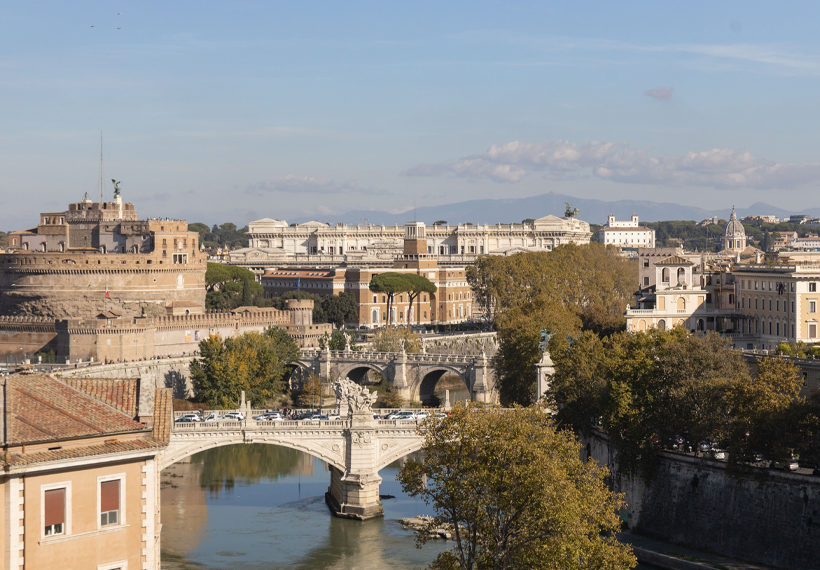
Day 2
Maps at the Vatican, ruins in a department store, and the ‘worst’ cocktail in Trastevere
“Are you ready to see the most famous work of art in the world?” I ask Kati, as we stand in the entryway of the Vatican Museums.
“The Mona Lisa?” she replies. She knows I mean the ceiling of the Sistine Chapel, but she’s a bit on edge at the moment; she doesn’t like crowds, and the assemblage of people in the lobby here is less a crowd and more a crushing horde. I give her hand a squeeze.
At least I booked one of the museum’s group tours (with skip-the-line tickets) ahead of time. Our guide, Valentina, starts us at a digital screen where she swipes through images of Michelangelo’s Sistine Chapel frescoes, explaining how the ceiling, completed in 1512, can be read panel by panel, like a comic book, and how the darker tone of the altar wall work, The Last Judgment, finished in 1541, reflects the influence that witnessing the 1527 Sack of Rome had on the painter. She’s giving this spiel ahead of time because guests are supposed to stay silent inside the chapel.
We won’t be seeing that room for a while yet, as it’s at the end of the tour, which zips through parts of 24 galleries that house masterpieces from Ancient Rome through the Renaissance. Kati likes baths, so her favorite part is the Museo Pio-Clementino’s Sala Rotonda, where a giant marble basin that belonged to Emperor Nero stands on an ornate mosaicked floor depicting mythical sea creatures. I love maps, so I geek out on the Gallery of Geographic Maps, a long hall lined with 40 topographical frescoes commissioned in 1580 to por- tray all the regions of Italy. “You are in front of the first Google Maps in history,” Val- entina says. At last, we reach the Sistine Chapel, although by the time we look up at that famous ceiling we’re mostly preoccupied with the amount of time we’ve spent on our feet.
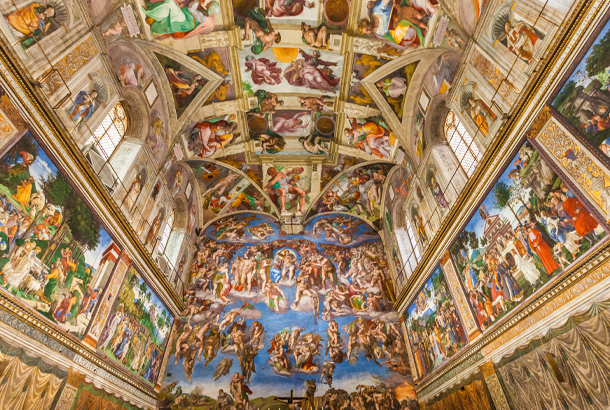
Kati needs something therapeutic after the crush of the museum, so we pass on waiting in line for St. Peter’s Basilica and instead take a cab to a place that will replenish her endorphins: the Rinascente flagship store in Trevi. She rides the escalator up to the women’s department to look at sweaters (she’s a designer by trade), while I go down to the basement, where I find the most Roman thing imaginable: a 2,000-year-old aqueduct tucked behind a retail display. We reconvene a little while later in the sixth- floor food hall, which includes an outlet of the Michelin- starred Neapolitan pizzeria Gino Sorbillo. The margherita we split is on the short list of best pies I’ve ever tasted.
After lunch, we retrieve our bags and head over to the Villa Agrippina Gran Meliá, a lavish resort in the shadow of the Vatican City walls. Kati needs a bit of downtime, but I’m in an exploratory mood, so I leave her to soak up the sun by the picturesque pool while I stroll down Gianicolo Hill, along the river, and into Trastevere, a traditionally working-class neighborhood that’s now widely considered the hippest part of town.

Wandering the narrow alleys and admiring the graffiti (let’s just say that contemporary Italian artists revere the female form as much as the Renaissance masters did), I soon bumble onto the Piazza di Santa Maria in Trastevere, where tourists sit and eat gelato on the fountain in front of the Basilica di Santa Maria in Trastevere. I poke my head inside to check out the 12th- and 13th-century mosaics, then continue on, making my way to the Basilica di Santa Cecilia in Trastevere. I gaze up at the ornate goldwork, the paintings and sculptures of angels, and think that the reverence with which this landmark church is regarded is truly justified… only, upon leaving, I realize that I was actually in the Chiesa di Santa Maria dell’Orto. Rome, man. (The Santa Cecilia, which I ultimately find just around the corner, and which features a Baroque sculpture of its namesake, is pretty snazzy in its own right.)
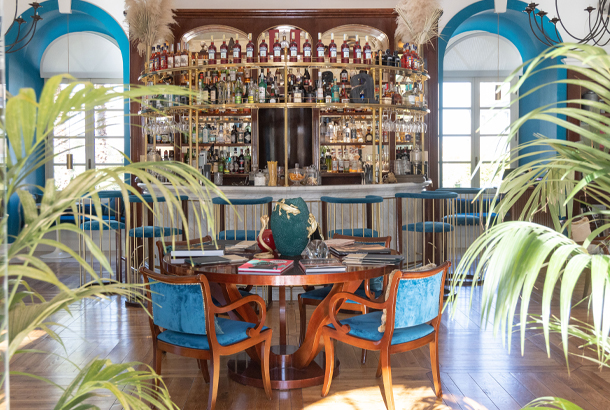
Retracing my steps toward the Villa Agrippina, I notice a bar called 404 Name Not Found with a chalkboard outside that issues a challenge: “Come try the worst cocktail one guy on TripAdvisor ever had in his life.” I step inside and ask the bartender what it is. “I can’t tell you,” he replies. “Are you up for the challenge?” Never one to turn down a stupid dare, I order the drink, which turns out to be something in the neighborhood of a whiskey or pisco sour. (Even after I’m done, the barkeep won’t tell me what’s in it.) Regardless, forget TripAdvisor; this aperitivo is Hemispheres-approved!
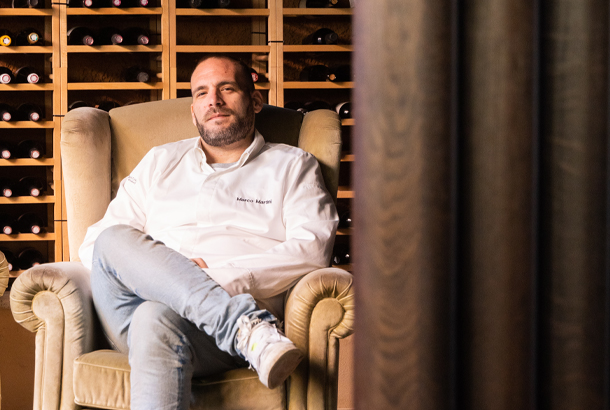
Back at the hotel, I pick up Kati, who has just emerged from the spa, and call a cab to take us to dinner. On the edge of another historically working-class, now-trendy neighborhood, Testaccio, we find Marco Martini, a Michelin-starred restaurant in a greenery-filled, pleasantly lit winter garden. The food here is definitely not standard trattoria fare. “The idea,” our waiter tells us, “is that we follow Roman tradition, but we have our eyes on the whole world.” Take the amuse-bouches that start the meal, which include egg shells filled with carbonara sauce, amatriciana in a tiny cone, and a ricotta marshmallow wrapped in prosciutto. We go on to order ’nduja and mascarpone bottone topped with steamed mussels and mussel foam, amberjack with a deconstructed Greek salad, and codfish with pata negra sauce and red cabbage foam. We don’t have room for dessert, but on our way out our waiter hands us a bag of cookies, “for breakfast tomorrow—or breakfast tonight!”
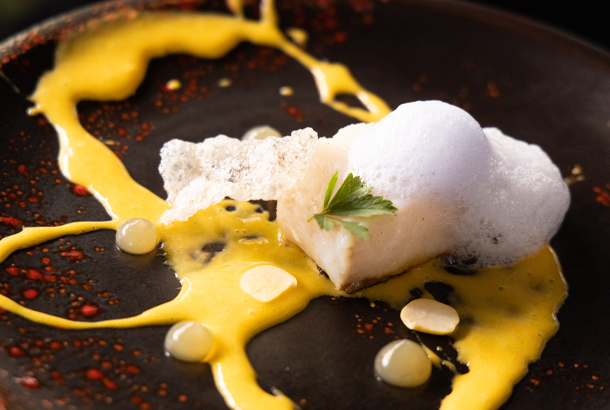
Keeping the ultra-modern theme going, we pop over to Monti for a cocktail at Drink Kong, a Japanese-futurist lounge that placed 16th on the most recent World’s 50 Best Bars list. Surrounded by stylish young Romans, a neon sign proclaiming “It was beauty killed the beast,” a poster of Rutger Hauer on the set of Blade Runner, and vintage arcade games, we settle into a booth and order: for Kati, a Red Light, with Bulldog gin, cassis, Cointreau, and grapefruit bitters; for me, a Rasna, with Bulleit Bourbon, shiitake, ginger, and honey. The alcohol rekindles my appetite, but Kati snatches away the food menu. “Let’s have breakfast instead,” she says, and she pulls the Marco Martini cookies from her purse.
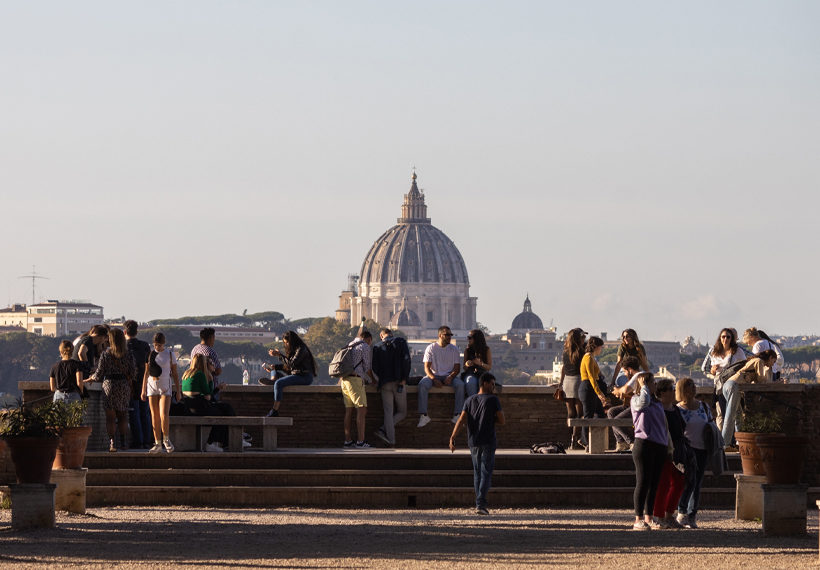
Day 3
Jewish artichokes, stray cats, and wishes upon a fountain
We start our Sunday the way every good Roman does. No, not at church—at the Porta Portese flea market. Every Sunday morning, vendors set up their stalls behind a centuries-old city gate in Trastevere, and thrifty locals and tourists brave the pickpockets to hunt for bargains. (It’s basically New York’s Canal Street crossed with Thunderdome.) We spend 30 minutes making our way down the aisle between the tent-shaded tables, but with no ending in sight and no off-brand jackets or handbags or sunglasses catching our eye, we beat a retreat while we’re still in possession of our wallets.
Upon exiting the old gate, we cross the river and climb a winding stairway up Aventine Hill to the Giardino degli Aranci. The orange trees aren’t in bloom, but our visit to the park does bear fruit, in the form of spectacular views of the Tiber, the Isola Tiberina, St. Peter’s, the Il Vittoriano monument, and countless church domes and bell towers.
We follow a cobblestone path back down the hill, and in short order a line of tourists indicates our next stop. Attached to the front of the Basilica di Santa Maria in Cosmedin is another location from Roman Holiday: the Bocca della Verità. Usually I’m averse to lines, but I insist we get on this one so that I can make like Gregory Peck and scream as I pretend the mouth in the 2,800-pound marble mask has bitten off my hand (as it’s said to punish liars).

Continuing along the river, we see ahead of us the square dome of the Great Synagogue of Rome. In 1555, Pope Paul IV ordered the city’s Jewish community, probably the oldest in Europe, be restricted to a small, often-flooded area next to the Tiber. The Jewish Museum of Rome, located inside the synagogue, relays the experience of life in the ghetto, and I’ve been looking forward to checking it out… except, upon our arrival, we find it’s closed for Sukkot. I’m such an observant Jew that I totally forgot about the holiday.
Oh well—I’ve always thought my people express our heritage best in the kitchen anyway. Among the many restaurants that line the old ghetto’s main street, we choose Casalino Osteria Kosher, starting lunch with the most emblematic of Roman Jewish dishes: the carciofo alla giudia, or Jewish-style artichoke. It comes deep-fried in a little basket, the delightfully crunchy leaves reminiscent of potato chips. Along with this tasty treat, our entrees—Kati’s saffron and asparagus risotto and my lightly battered cod with pine nuts, tomatoes, and garlic—confirm my pride in Judaism’s ongoing contributions to world culture.
If the Jewish quarter was the place I was most looking forward to visiting today, our next stop is Kati’s. A few blocks from the ghetto’s exit is the Largo di Torre Argentina, an ancient square where historians believe Roman senators assassinated Julius Caesar in 44 BCE. What draws my girlfriend’s interest, though, are the half dozen or so cats lounging in the nooks and crannies of the old stone walls. After the site was excavated in the 1920s, it became a habitat for stray cats, and two of the gattare (cat ladies) who fed them later went on to found a cat sanctuary. Kati swoons at the felines outside, then descends the stairs to the underground shelter where dozens of others are being cared for. I’m allergic to cats, so there’s no way I’m following her into that room; I go across the street to Caffè Camerino and order an Aperol spritz.
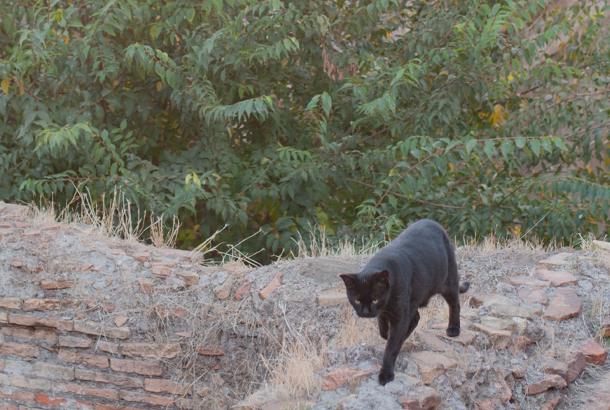
I’m halfway through my second spritz when Kati finds me at the café, and I lead her to an animal that won’t make me sneeze: the Gian Lorenzo Bernini–designed marble elephant at the base of the obelisk in the Piazza della Minerva. I’m not the only one who prefers pachyderms—when we walk up, a dad and a little girl in a pink dress are posing for a picture in front of the 2,600-year-old Egyptian obelisk. After they’re finished, we do the same.

We need to get off our feet for a few minutes, so we head to The St. Regis Rome. First opened by César Ritz in 1894, the hotel is surrounded by sensational sights—among them the 1,700-year-old Terme di Diocleziano baths, the monumental Fontana del Mosè, and the Chiesa di Santa Maria della Vittoria, which houses its own famous Bernini statue—but the ornate lobby, with its chandeliered ceilings and mosaicked floors, is as jaw-dropping as any of them. We take the original elevator up to our suite for a bath, a bit of bubbly, and a view from our window of the sun setting over the Santa Maria della Vittoria.
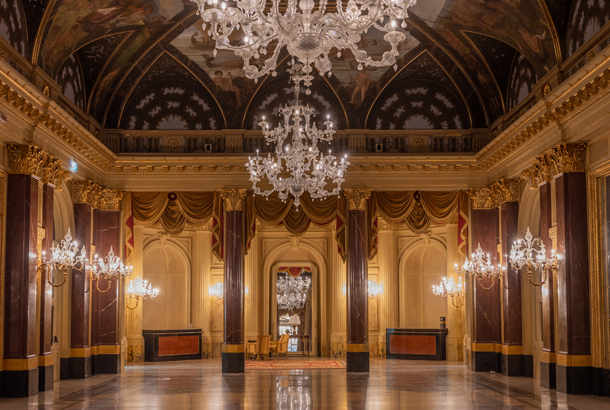
Refreshed, we stroll around the Palazzo Quirinale and down an alley to Piccolo Arancio, a charming restaurant lined with distressed mirrors and wine bottles. We share a sampling of classic, homey dishes—fried zucchini blossoms, tagliatelle with lamb ragù, spaghetti with clams and mussels—and a
local Frascati white wine. It’s the most relaxed we’ve felt all weekend.

Content, we step out into the night, and right around the corner we find our last stop: the Fontana di Trevi. We’ve saved the famed Baroque fountain for the end, because we’ve heard it’s brilliantly lit at night (true) and less crowded by tourists than during the day (false, at least as far as I can tell). “Marcello!” I call out, doing my best Anita Ekberg imitation, but I’m not interested in spending the night in a Roman jail, so I don’t try to wade into the pool. Instead, we make our way through the crowd to the water’s edge, where we stop and turn our backs. I fish a few coins out of my pocket and hand three to Kati. “Remember to use your right hand, and throw them over your left shoulder,” she reminds me. The first coin guarantees that you’ll return to Rome, the second that you’ll find love there, the third that you’ll marry. We smile at each other and toss the coins.
Take a Roman Holiday: Beginning this summer, choose from five daily nonstop flights to Rome from four U.S. cities: Chicago, New York/Newark, San Francisco, and Washington, D.C. United is the only U.S. airline to fly nonstop between San Francisco and Rome.

